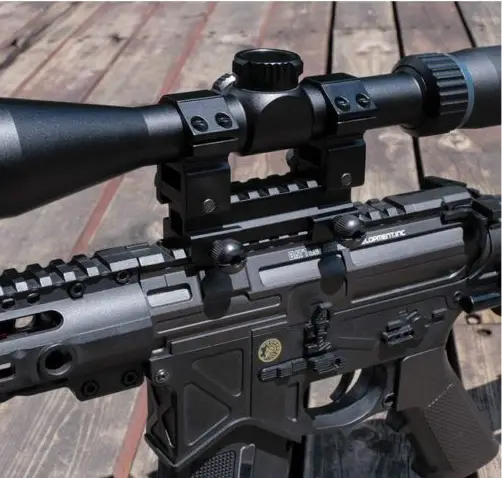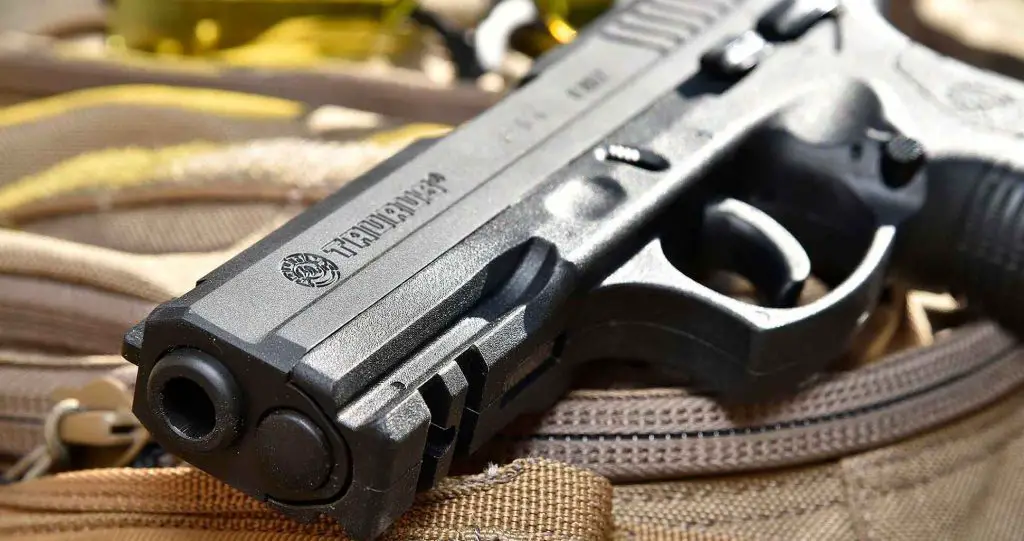
Ultimate Guide to Semi-Automatic Pistols
As the sales of firearms rise and more and more people see the value in keeping a handgun close by, the semi-automatic becomes an even hotter commodity.
These nifty handguns come with a whole range of benefits for the average civilian and armed soldiers, as long as you know how they work.
What is a semi-automatic pistol? A semi-automatic pistol is a type of handgun with a single chamber designed to make reloading and firing faster.
The action is automatically cycled so that the new cartridge is inserted into the chamber, but you still need to press the trigger with your finger to discharge the weapon.
A semi-automatic pistol is the best way to arm yourself and get instant protection for your home and family.
To be a responsible firearm owner though, you need to equip yourself with the facts about these handguns so you can use them safely and effectively.
What Does Semi-Automatic Mean?
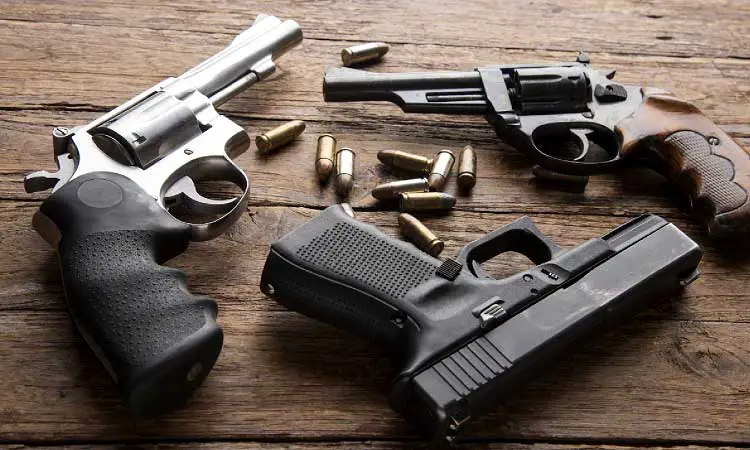
One of the first things to learn before investing in your very first firearm is what semi-automatic really means and how it differs from the rest.
When the term ‘semi-automatic’ is used when describing a gun, it means some components of the firearms’ mechanisms work automatically, but not all of them, hence the ‘semi’ label.
As you pull the trigger of a semi-automatic pistol and the cartridge is fired, gas pressure moves the next one into the chamber.
The operator of the gun is then able to pull the trigger repeatedly without doing any of the manual reloading themselves until all of the cartridges in the magazine have been used.
Although there’s no need to reload, you will need to cock the firing mechanism of the gun, usually with a slide function.
This sometimes requires a good amount of hand strength so some aspects of it can be harder than using a single shot or manual repeating model.
A standard semi-automatic pistol can hold between six to 18 rounds, so depending on where you plan on using it and what type of protection you’re after, you should choose the capacity to suit.
Unlike other types of guns where you must perform the loading action yourself, using a semi-automatic firearm saves a lot of time, and makes it easier to operate overall.
The History and Evolution of Pistols
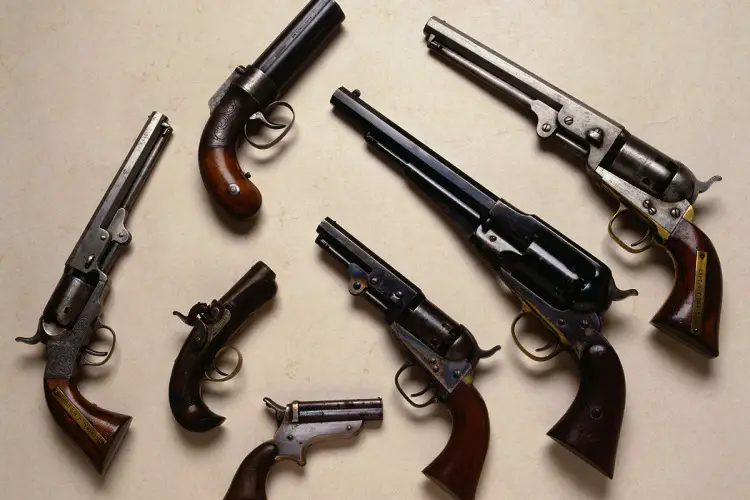
To get an idea of where the pistol of today is, it helps to look back to the past and see where they’ve come from.
The word ‘pistol’ was first introduced around 1570, coming from the French word ‘pistolet’ which referred to any small knife or gun.
Today, the word is only used to describe a handgun but can include everything from revolvers to derringers.
The semi-automatic first came about after a recoil-powered machine gun was invented in 1883, and ideas for a self-loading firearm were first revealed in the 1880s as well.
The very first semi-automatic pistol was called the Salvator Dormus and then the Schonbuerger-Laumann in 1892.
Although there had been some iterations, the first successful semi-automatic was the C-93 from Hugo Borchardt.
This handgun had a 7.65mm cartridge and used a locking mechanism that would later be found to be too bulky, and so in 1896, the Mauser C96 was released and considered the first mass-produced semi that had a large capacity of up to 20 rounds.
From there, many developments were made, until John Browning released some of his self-loading semi-automatic pistols in 1896.
In these designs, we saw the use of a locked-breech action that is still in use today, although the rest of these firearms features have been upgraded to be even more reliable and accessible for the user.
Revolver vs Semi-Automatic Guns: What’s the Difference?
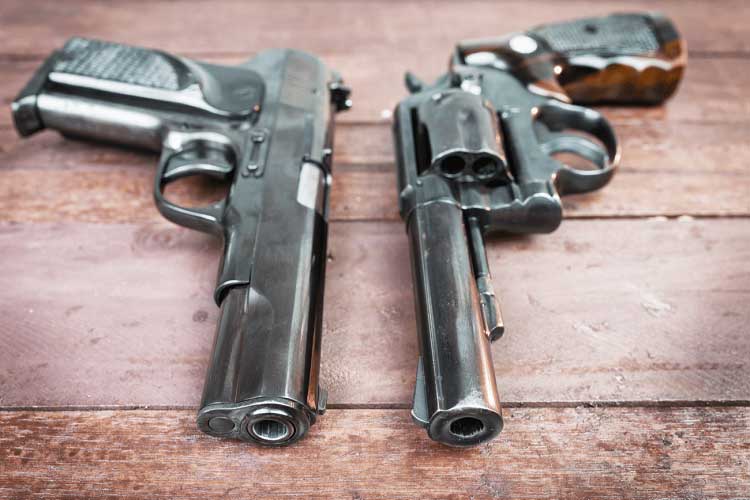
In the world of handguns, the pistol and the revolver are the two leading stars.
For those without a deep understanding of firearms, it’s easy to assume that the semi-automatic pistol is one and the same as a revolver, but this couldn’t be any further from the truth.
Unlike a semi-automatic, a revolver has a revolving cylinder operating at its core which holds the ammunition.
As the trigger is pulled, the hammer is cocked and the round is fired, all at the same time, however, there are some double-action revolvers out there as well.
Due to the rounds being loaded one at a time, it has a slower reload, which might not make it suitable for everyone.
Although it appears that these guns are unalike, they have a lot of similarities.
Some people assume that the revolver is harder to operate which isn’t always true, especially for those with experience, and the only main difference is learning how to rack a slide on a semi-automatic which doesn’t take much at all.
The truth is, every shooter is different and what they feel comfortable in terms of firearms, grip, shape, and size of a weapon will be different as well.
This could mean a revolver or a semi-automatic is more your style, and it deserves a lot of thought and in-person practice to figure out what your flavor is.
Ammunition Choices
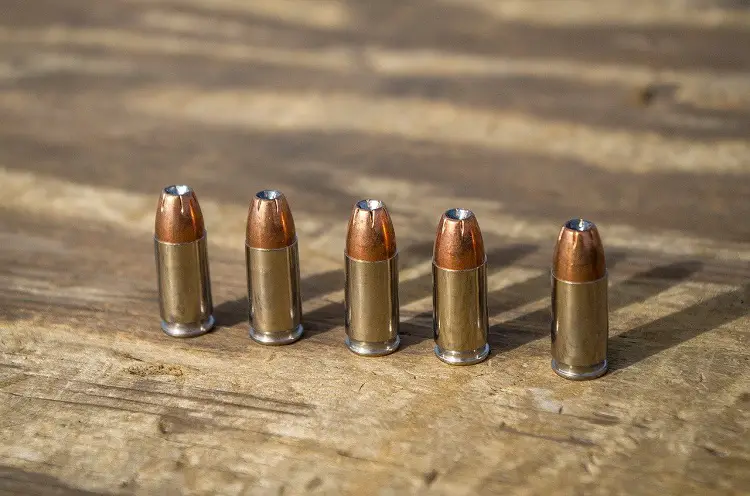
One of the major benefits that come with semi-automatic ownership is the fact that they have greater ammunition capacity and quicker reloads.
However, this doesn’t apply to every type of ammo used with these guns. These are some of the more popular ammo choices for semis and how each of them can impact your shot:
.380 ACP
The .380 ACP is sometimes referred to as a 9mm short cartridge because it’s just like a compact version of this more powerful alternative.
The .380 ACP is commonly seen in compact pistols and semi-autos and it’s better suited to close range while offering low recoil and gentle use for the shooter.
9mm
Arguably the most popular caliber firearm you’ll see, the 9mm, is sometimes also called the 9mm Luger which is its technical name.
The 9mm is a top choice for target practice and self-defense, has good penetration, and is readily available so it ticks all of the boxes.
.45 ACP
The .45 ACP was designed over 100 years ago and is still a popular choice of caliber today.
As one of the larger projectiles, you’ll find coming out of a handgun, it should be no surprise that this one has around 230 grains inside of it. However, the recoil is more noticeable so it’s not a good choice for newcomers.
.40 S&W
The .40 from Smith and Wesson is famous for being the FBI’s chosen cartridge once upon a time, and it varies in weight depending on how much force you need, from 155 through to 190 grams.
This is a big bullet that packs a punch and it means serious business, so if your semi-automatic has a lot of work to do, you can put your trust in it.
Self Defense With the Semi-Automatic

The semi-automatic handgun has become the most popular choice for people wanting to defend themselves, and it’s the most common type of gun that’s concealed carried.
Once you’ve improved your skill and learned how to take an accurate shot, you’ll want one of these pistols by your side constantly for peace of mind.
The benefits that a semi offers in a self-defense situation are faster reloading, larger magazine capacity, and more compact size.
You’re able to conceal them easily on your person and access them quickly and easily, which could save you precious seconds in a life-or-death situation.
Some of the more popular semis used for self-defense include the Browning Black Label 1911-380, Sig Sauer P365, Glock 19, and Smith & Wesson M&P Shield 2.0.
These guns range from compact to full-size frames, varied capacity, and calibers, but are all easy enough to carry on your person and access quickly when you need them.
Care, Cleaning, and Maintenance

For all of their perks when it comes to ease of use, most people find cleaning their semi-automatic handgun to be a lot more work than a shotgun or rifle.
That’s because there are more moving parts inside that need your attention, but with just 10 minutes of attention after every use, you can tend to them with ease, so follow these steps.
- Following safety protocols, always ensure that you’ve removed the magazine of your weapon. Check to make sure there are no rounds in the gun and that it’s unloaded.
- Use a dry brush first to get rid of any debris inside the chamber and the barrel of the gun, including fouling. For this purpose, something made of nylon or copper-phosphate is best, and preferably a dedicated bore brush that will fit inside.
- Dip a cleaning patch into your chosen bore solvent and put it on the cleaning rod, then insert it into the barrel and push it out the other side. This will give a further clean inside. Leave it to sit for 15 minutes so it breaks down the fouling.
- Clean the inside of the barrel with the bore brush and gently scrub it. Take a dry cleaning cloth and push it back and forward through it to get any leftovers.
- Apply a gun-suitable lubricant to a bore snake and rub it onto the surface of the bore. This will protect it from corrosion.
- Wipe down the outside parts of the gun including the barrel and feed ramp.
- Spray the action at the top so that the debris and carbon come out and catch any of it in a drip pan that you’ve set up in preparation.
- Lubricate the rest of the gun in the recommended parts, including all components of the action. Use an application to place drops of the lubricant that are mentioned in the owner’s manual, including the outside of the barrel and the slide assembly.
- Remove the magazine, take it apart, clean it, and reassemble it, using only cleaning products and tools designed for this component.
- Once all parts have dried, reassemble them together in the same order that you disassembled them. Test the weapon with a functional check before firing it.
Improving Your Aim A Semi
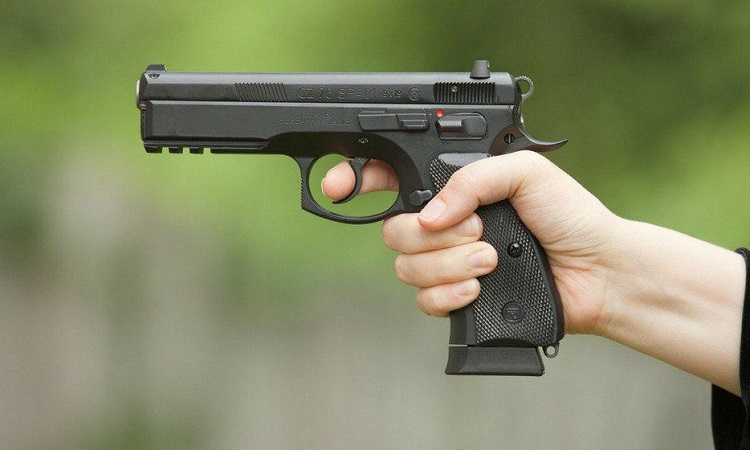
On the outside, a handgun can look pretty simple to operate. It doesn’t have the bulk of a shotgun or the length of a rifle, so it should be easy to shoot accurately, right?
This couldn’t be farther from the truth though, as the handgun requires a better grip and much greater patience from the shooter to aim it correctly, so be prepared to put in some work.
A semi-automatic handgun can be hard to master because of the position your body is in, with your arms extended out in front and all of the recoil, muzzle flash, and noise you have to deal with.
Accuracy is the goal for any firearm owner but it’s made even harder with a handgun because of these, which is why more practice is required, especially when it comes to the trigger.
Improving trigger control appears to be the key to improving accuracy with a handgun and because each type of handgun comes with its own trigger configuration, you’ll need to master whatever one you’re using.
The exact pressure and force needed to employ the trigger can differ dramatically, but once you’re able to get a grip on this, accuracy becomes easier.
If you’re hoping to improve your accuracy with a handgun, some accessories can help.
Consider adding one of these to your firearm setup and see if it can give your semi-automatic that accuracy you’ve been craving.
- Shooting rest: A shooting rest or shooting bag can help with one of the biggest problems of handguns – having somewhere to place your arms while you line up the shot. With your hands and arms rested on one of these bags you’ll get the stability that a rifle enjoys, and it’ll help you steady your shot.
- Sights and optics: There’s no shortage of sights and optics you can add to a handgun but you need to make sure they’re compatible. If you plan on using things like laser sights, check the firearm you own first and see what it works with before jumping the gun. Otherwise, work backwards and think about what accessories you don’t want to live without, and then choose the gun that suits this.
- Targets: Whether you want to make your own with some pieces of paper or purchase ready-made ones, you’ll need some targets to practice with. There’s no miracle cure out there that can turn you into a precise marksman overnight, so it takes a lot of practice at the range with targets to improve your accuracy.
Semi-Automatics and Responsible Ownership

The most important thing to learn about pistols by far is how to use one safely, and this includes when it’s not in use, like storage and cleaning.
We’ve got some tips that are essential to put into place when you own a semi-automatic handgun so make sure you follow them.
- Assume your gun is always loaded: The safest way to handle your gun is by assuming that it’s always loaded, even if you’re pretty sure that you just emptied. Getting into the mindset that your gun is always loaded means less likelihood that you’ll accidentally discharge it or face some other sort of problem. Even when you can see there’s no magazine in the gun, you should still assume there is, and this goes for when it’s not in your hands either.
- Use two hands to grip: Although the very nature of a handgun is such that you can operate it with one hand, that doesn’t mean you should. To ensure the safest handling and most accurate shot, you should use two hands to grip the firearm. This can take some getting used to and it might even feel unnatural at first, but developing a safe and expert-recommended grip is the key to safety.
- Clear the gun after use: When you’re done with firing your weapon and before you start using it for dry firing, make sure you remove the magazine entirely. Once it’s cleared, point the gun downrange and rack it to be sure it’s empty, and then place the empty magazine back into the gun.
- Know Your Target: Safety with firearms isn’t just about the weapon itself, but understanding how to identify your target and be able to tell what’s behind it as well. Bullets are high velocity and extremely damaging, so it’s important to understand how they travel and what their penetration rate is so you don’t hit anything other than the target.
- On target and on trigger: A simple mantra that every handgun owner should learn is “On target, on trigger. Off target, off trigger.” This means that your finger does not touch the trigger of the gun until it’s pointed at the trigger. If it’s not on the target, then your finger should be off the trigger as well.
- Never point the muzzle anywhere else: In the same vein as the previous rule, it’s crucial to never point the muzzle anywhere other than where you’re about to shoot. Even if you can guarantee that the firearm has no rounds in it or some of the crucial parts are missing, you should never aim it at someone or something. The number of incidents caused by breaking this rule alone are far higher than they should be.
- Keep it clean: A clean gun isn’t just a nice-looking gun, but a reliable one as well. A quality handgun has the potential to last for more than a century but you need to take care of it. The last thing you want happening when you’re in a critical situation and have to rely on your firearm to save you is something jamming up or not working because it’s full of debris and fouling. After each time you fire the gun, give it a quick clean, and if it’s stored for longer than three months at a time, take it out and inspect it, cleaning as needed.
The Simplicity of a Semi
As you can see, there are plenty of reasons why the semi-automatic holds the title as one of the most prized firearms in the US.
Whether you’re looking to concealed carry or want some simple home defense, there’s nothing like a semi-automatic pistol to deliver efficiency and ease of use.
Related Questions
A semi-automatic is just one type of handgun out there, but it’s one with the biggest benefits to a civilian.
If you still have more questions about the types of handguns and their uses, we’ve answered some FAQs that can give you a push in the right direction.
Are All Handguns Semi-Automatic?
The best way to categorize a handgun is one that can be held and operated in a single hand, but not all handguns are semi-automatic.
Some pistols can be classed as automatic weapons because they shoot multiple rounds at once without any input from the operator.
How Long Does a Semi-Automatic Pistol Last?
A well-made firearm like a semi-automatic pistol can last for hundreds of years with the right type of care, including regular cleaning and maintenance or repair of its smaller parts.
The most durable types feature a stainless steel frame but the inner mechanisms are just as important to take care of as well.
What Brand of Handgun is the Best?
In the United States, there are a handful of handgun manufacturers that are considered the best of the best, and this is reflected in their sales figures.
Glock, Sig Sauer, Smith & Wesson, Heckler and Koch, Springfield Armory, and Sturm, Ruger and Co. are some of the names you always see at the top of the list for favored brands.
Resources:
![5 Best Pellet Guns Under $100 [2023] 11 bb rifle gun](https://www.armorholdings.com/wp-content/uploads/2022/11/bb-rifle-gun.jpg)
